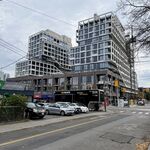As W. K. Lis just said, the surface sections on Eglinton will have their own lanes, plus the intersection spacing on those sections is much wider than on Spadina, allowing for much more effective signal priority (especially with new GPS tracking technology). Given this, and the current traffic gridlock at rush hour, how could Light Rail vehicles possibly operate any slower than busses

I hope that you're right. I certainly don't have your faith in the TTC adopting modern signal priority with GPS tracking. Considering that we've heard nothing about it so far, I wouldn't be surprised if, at best, the TTC decided to create some homemade signal priority system based on their own technology from the 70s, a la CIS.
Given the terrible traffic congestion on Spadina, how is it that the streetcar still manages to be as slow as the old mixed-traffic bus?
I think we have to do better than "faster than buses" if we're going to spend $8 billion on these routes. They've got to be time competitive with the subway, and I certainly don't see that happening.
It is likely that longer 3 car LRV's (about the same length of a 4 car subway train) would be short turned within the tunneled section, or to Jane and Don Mills at the most, and 1 or 2 car LRV's would travel from end to end.
I'm hoping they adopt some kind of system like that. Hopefully the short-turned cars would be frequent enough to provide a reliable service in the tunnel even if the TTC completely bungles operations on the surface sections.
I would also assume that station spacing in the tunneled section would be similar to a regular subway, considering how expensive each one would be. ( at least $75 to &100 Million)
Which is absolute madness. Why do stations in Toronto have to cost as much as subway lines in other cities? Simply because they're massively overbuilt. Why does a station like Bessarion need a vast mezzanine with underground fare control. I think the model for all but the busiest future stations should be Wellesley. A simple surface building with fare control and perhaps a little bus terminal, with escalators right down to the platform.
The station at the 407 Transit way will cost $90 million dollars. This is for an underground station beneath undeveloped, government-owned land. The TTC actually included a brief examination of running the line elevated at that point, including an elevated station, and determined it is feasible. Unfortunately, it would be at a slight inconvenience to operations based on the angle of approach from a pocket track, so it was dismissed out of hand as an "inferior" option. There was absolutely no examination of relative costs of the two options, which boggles the mind considering that with the station alone costing $90 million, elevating that section could save hundreds of millions of dollars at an insignificant cost to operations.




